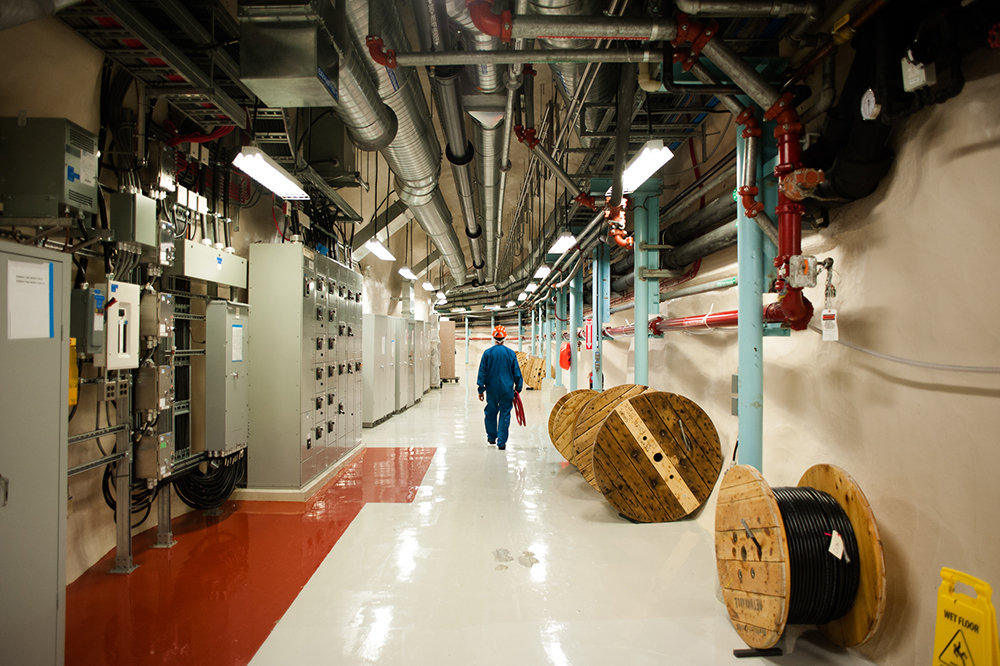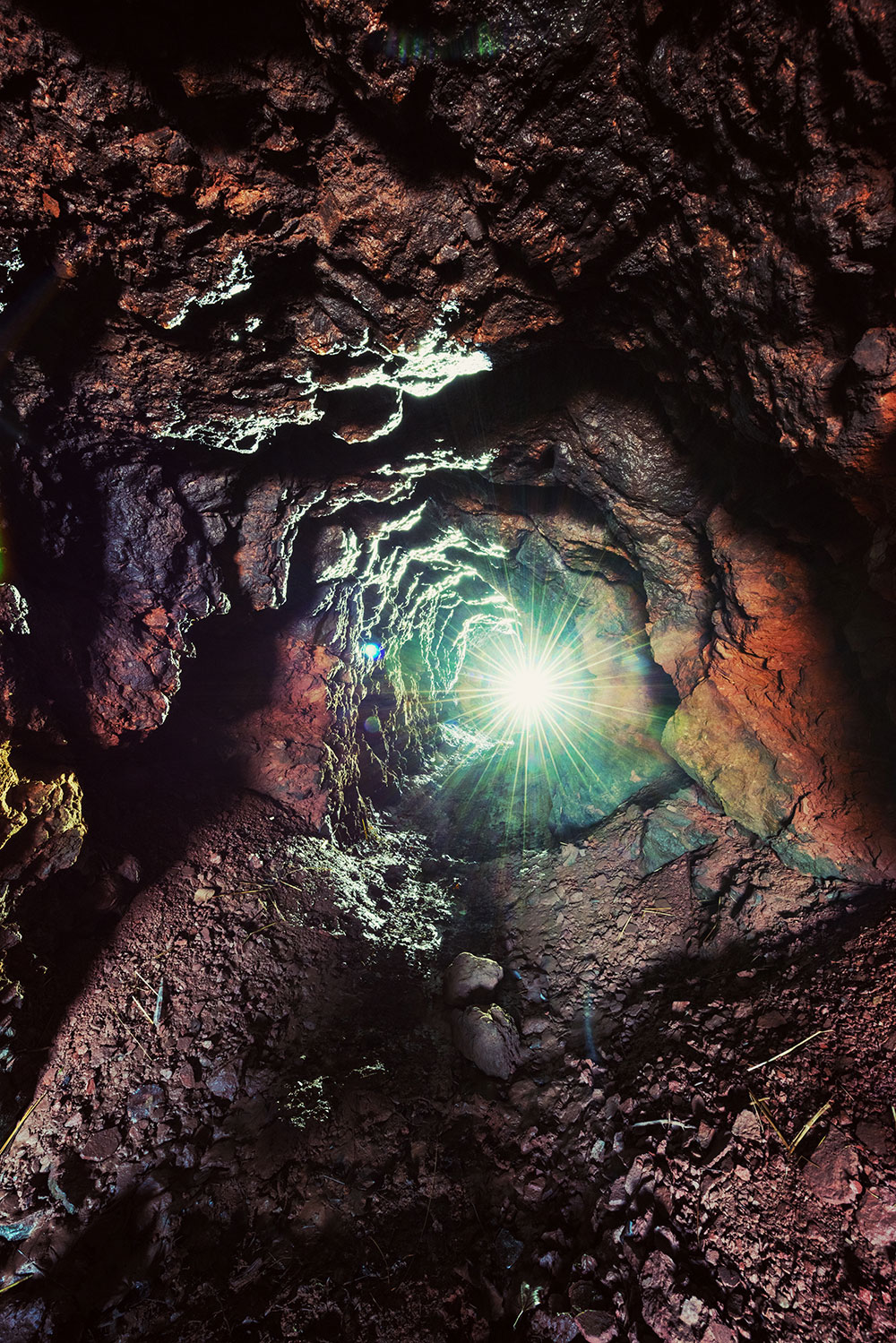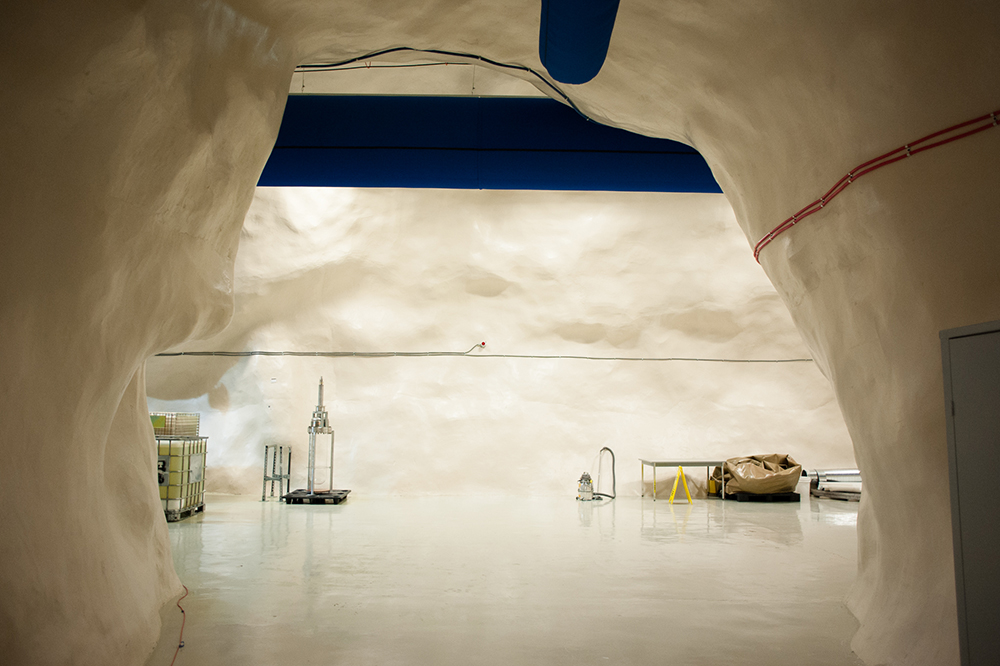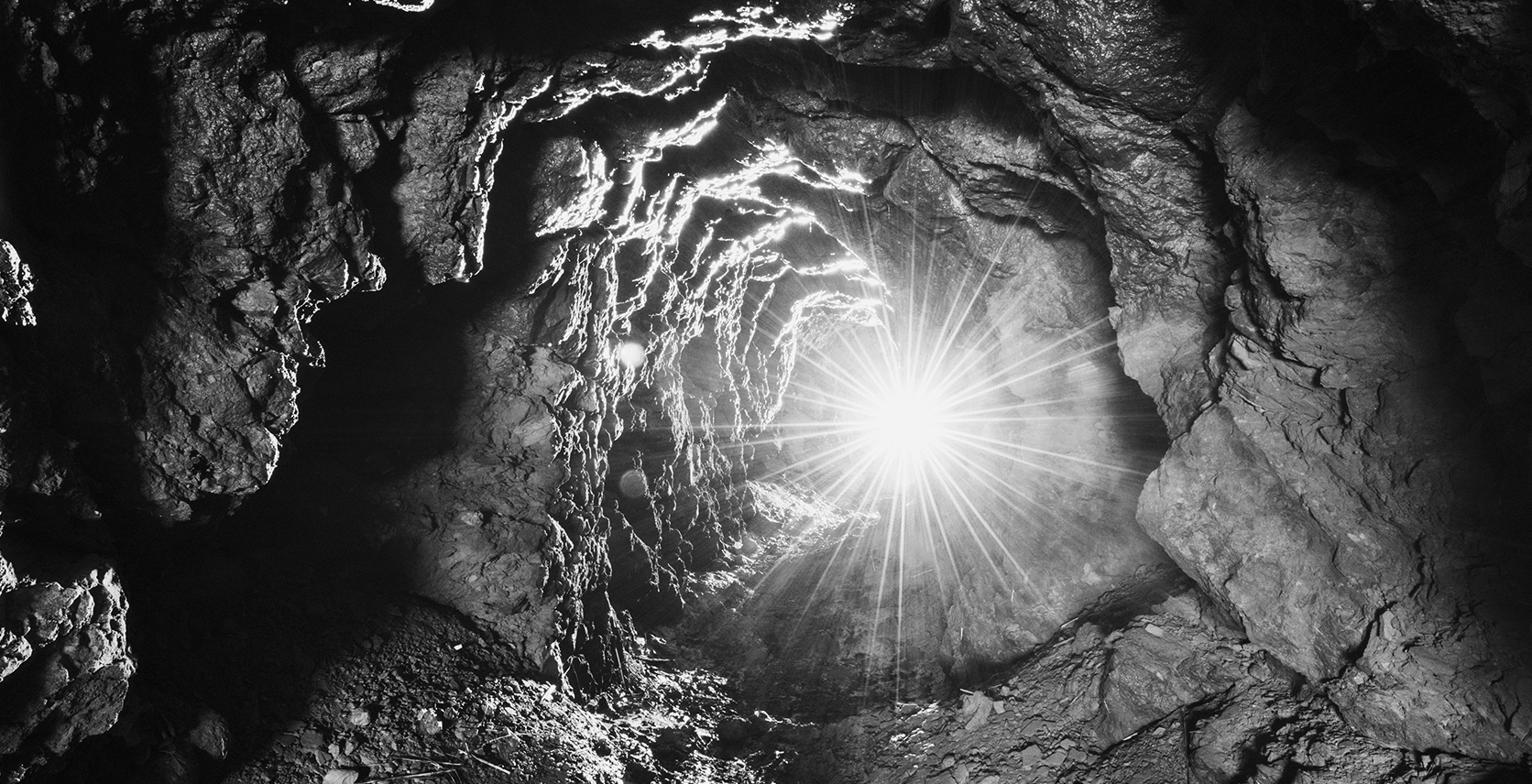Inside Canada’s Subterranean Search for Dark Matter, Physics’ Holy Grail
There is a profound hole in the earth near the northern Ontario town of Sudbury — and it just may hold the answer to the greatest mystery in the universe. Shaft No. 9 in Vale’s still-operating century-old Creighton Mine reaches more than two kilometres below the surface of the Canadian Shield, a depth of about four stacked CN Towers.
You reach the bottom via the “cage,” an unlit double-decker iron conveyance that carries employees and equipment down through 2,100 metres of dirt and rock to the various drifts, or horizontal tunnels. The cage is hot, and dark, and goes so deep so fast that you feel the pressure in your ears like in a landing plane.
Descending into the bowels of the mine shaft — dug to recover the mineral deposits left after a meteor, or perhaps comet, crashed here 1.8 billion years ago — you’ll find orange coverall-clad miners looking for nickel and blue coverall-clad physicists looking for…nothing.
Well, not exactly nothing.
The scientists here at SNOLAB — the second-deepest laboratory on the planet with 5,000 square metres of dynamite-blasted tunnels, caverns and pits — are looking for something down in this corner of the mine. It’s just something nobody has ever been able to find. It’s also something believed to make up 85 per cent of all mass in the universe.
They’re in search of dark matter.
Imagine you lived by a lake and believed it contained all the water in the world, then discovered that oceans exist. Mind blown and world changed, right? That’s what happened when scientists realized, based on how gravity was working in deep space, there must be a lot more stuff out there then what we could see — seven times more, to be exact.
They dubbed it “dark matter,” and believe its presence shapes galaxies and links them in a cosmic web holding creation together. But so far they’ve still only seen its effects — like seeing rustling leaves but not the actual wind.
That’s why the hunt to identify the still-hypothetical substance is ramping up down here in SNOLAB where scientists are building SuperCDMS, their bleeding-edge cryogenic dark-matter detector.

The rock overburden filters out the cosmic rays constantly bombarding the planet’s surface, upping their chance of catching this elusive invisible particle as it passes right through our planet. Already home to Nobel Prize-winning work on neutrino “ghost particles” — thousands of billions of which are currently passing through your body as you read this — SNOLAB could be on the brink of an even more revolutionary discovery that fundamentally alters our very understanding of reality.
“We’re playing hide and go seek with the universe right now,” explains SNOLAB staff scientist Tom Sonley, an MIT-educated astrophysicist, from his deep underground workspace. “It’s very exciting to be able to search for these particles that we have hints are hiding there. We’re just at the point where we think we know where it is — and that’s why there’s this big race.”
Dark matter is physics’ Holy Grail. NASA says “there is no current problem of greater importance to cosmology than that of dark matter” and Astronomy magazine compares its importance to air: “ubiquitous, necessary, unseen but felt.” But SNOLAB is not the only Indiana Jones on this last crusade. In similar deep holes around the planet, you’ll find China’s PandaX detector, Italy’s Xenon, America’s Lux-Zeplin, ADMX and DarkSide-20K, and Japan’s Super Kamiokande as well as the KM3net at the bottom of the Mediterranean sea and the perfectly named IceCube deep under Antarctica. Each dark-matter detector is using a slightly different technique or seeking a slightly different particle. All their teams hope to be first to figure out what the hell most of everything is actually made of.
While scientists try to nail down the facts, dark matter’s enigmatic nature has also made it a science-fiction mainstay. You’ll find it everywhere from Star Trek to Marvel movies. It fuels video game guns and is the titular substance of Philip Pullman’s acclaimed book trilogy His Dark Materials, currently being adapted into a BBC/HBO series they hope will be the next Game of Thrones. (Starring Hamilton’s Lin-Manuel Miranda, X-Men leader James McAvoy and that badass little girl from Logan, it’s been renewed for season two before airing an episode so you’ll soon be hearing a lot more about fictional dark matter.)
“It’s an easy hook to hang stories on because we don’t really understand what it is,” says SNOLAB director Dr. Nigel Smith of its pop cultural prevalence, mentioning offhand that the recently knighted British author once visited his old UK lab.
“I have a photograph of [Pullman] sitting with one of our detectors that we deployed underground. I should’ve heard about that show and got onto the technical side of things, right? That’s a shame,” he adds.
Smith started his career working on a PhD in the South Pole. In 1987, he built and operated an “air shower” telescope, and was the first Brit to successfully winter over at the pole. By the early 1990s, he’d relocated from the bottom of the planet to the bottom of a Yorkshire salt mine in northern England. The astroparticle physicist went from scanning the skies for gamma rays to looking for galactic dark matter 1,100 metres underground.
Smith’s role included building out the infrastructure for the UK’s dark matter program, developing liquid xenon detector experiments, and managing the lab in the Boulby mine. He was a natural choice when SNOLAB wanted to turn their sights on solving a new cosmic mystery and, in 2009, Smith crossed the pond to start up the deep underground dark matter hunt.
“We haven’t identified yet what the dark matter consists of. But we know it’s there,” Smith says confidently. “There is very strong evidence on all cosmological scales.”
•••
Dark matter theory first began coalescing back in the 1880s when pioneering physicist Lord Kelvin suggested, based on observations of the Milky Way, that “many of our stars, perhaps a great majority of them, may be dark bodies.” A couple decades later, French physicist Henri Poincare dubbed it matière obscure, or dark matter, though these early understandings were primitive at best. With improving telescopic technology showing the movements of distant galaxies by the 1930s, Swiss astronomer Fritz Zwicky concluded the laws of gravity only make sense if there is way more matter in the universe than we can see. Matter that does not emit, absorb or reflect light. Dark matter.
These theories were largely ignored at the time, falling to the wayside during the atomic age. But by the 1970s, science and technology had advanced enough to dig back in. We still couldn’t see dark matter, but the work of astronomers like Vera Rubin provided mounting gravitational evidence of its presence and set scientists off on their ongoing mission to find it.
Which brings us back to, or rather under, Canada. SNOLAB’s name comes from Sudbury Neutrino Observatory. Built in the 1980s, which gives the place the retro-futuristic feel of a Cold War nuclear bomb shelter, the mine’s depth offers 50 million-times less cosmic radiation than the surface. This allows researchers to separate the signal from the noise.
“If we can identify that, yes, this is a new particle that constitutes 85 per cent of the mass of the universe? That would overhaul nature as we understand it.”
Dr. Art MacDonald’s work down here was awarded a Nobel Prize in 2015 for proving neutrinos have mass, confirming “how the sun burns,” and cementing Canada’s status as a world leader in particle astrophysics.
“The success of SNO has really allowed the Canadian community to plant its flag in underground science generally,” Smith adds. “People want to come here to do their science because this is such a fantastic location, and Canadian researchers can then springboard on that.”
There is a lab in China a hundred metres deeper, but it’s not a “clean” lab like SNO. To even further reduce radioactivity, the entire research facility is a Class 2000 cleanroom to eliminate mine dust that contains millions of particles of uranium and thorium. So before entering workers and visitors have to shower, shampoo, and change into lab-only undergarments, coveralls, boots and safety helmets with headlamps.
SNOLAB has a number of ongoing experiments in collaboration with a host of Canadian and international institutions. There’s still neutrino work being done — HALO, for instance, uses the tiny little guys to track supernova explosions — but most focus now is on running dark-matter detectors like PICO, DEAP-3600, MiniCLEAN and DAMIC and setting up SuperCDMS. They sit in spaces like the Cryopit and Cube Hall, make use of liquid argon, ultraclean quartz vessels and bubble-chamber technology, and look pulled right out of a steampunk graphic novel.

The theory being tested here is that dark matter is a WIMP, or weakly interacting massive particle. That means they mostly pass through the planet without touching anything. Imagine you were doing the Bird Box Challenge on a football field with a few scattered pylons. Chances are you wouldn’t bump into any of them, but do it enough times and you might. That rare interaction is what all these detectors are seeking, and clocking one could change everything.
“If we do see these particles in the wild and can identify that, yes, this is a new particle that constitutes 85 percent of the mass of the universe? I mean, that would be a massive overhaul of the model of nature as we understand it,” says Smith. “It would be a paradigm shift.”
Though the phrase has become a cliche, humanity has been shaped by such shifts as our understanding expands outward and inward. That the Earth is round, and revolves around the sun. That everything is made of atoms, and every atom is made of even smaller things. Each discovery has led to countless unexpected outcomes, for better and worse, from the Scientific Revolution and colonialism to the atomic bomb and smartphones.
Smith likes to point out that the electron was discovered only 122 years ago. “There used to be a toast in Cambridge: ‘to the electron, long may it be useless,’” he says, throwing shade on that era’s inability to grasp the changes they’d wrought. “Where would the world would be now without our understanding of what an electron is and how it behaves? Everything is related to electricity. All things flow from that.”
Now, we find ourselves on the verge of finding out what might flow from the discovery of dark matter.
•••
Dr. Jeter Hall, SNOLAB’s director of research, has been in Sudbury since the fall of 2017. Though he came to what he considers the “best lab in the world” from a U.S. Department of Defense gig working on projects he can’t really talk about, Hall began developing earlier iterations of the ultra-cold CDMS dark matter detector a decade ago in the bottom of a Minnesota mine.
SuperCDMS will be looking for infinitesimal vibrations in a stack of hockey puck-shaped crystals. Made of silicon and germanium, the pucks will be cooled to a fraction above absolute zero to increase their sensitivity to a dark matter collision. Thanks to a recent influx of funding — $31 million from the U.S. government with a $3 million top-up from Canada — the detector’s kinks are now being worked out inside CUTE, the cryogenic underground testing facility, and data should begin rolling in by 2022.
“Then we can start to measure how dark matter interacts with the matter we know and love,” Hall says with an optimistic grin. “Are there other interactions that we can bootstrap from this one toehold? Can we start to probe how dark matter interacts with itself? Are there unique fundamental properties to this dark matter that we’re not even thinking of right now that we could exploit in the future?”

That potential exploitation is unknowable for now. But as with Smith’s electron example, Hall says more recent scientists thought quantum mechanics would be useless until it led to quantum computers, quantum optics, and quantum cryptography.
“People ask, ‘what good is it?’ But what’s the use of a newborn baby? You don’t really know, but you know it’s probably going to be valuable. That it’s 85 per cent of the matter in the universe is compelling enough that dark matter’s gotta be useful for something beyond just forming galaxies.”
Or maybe not. One possibility is that it’s not a WIMP at all. Another is that we’ve had gravity wrong all along and there is no dark matter. “There are lots of opportunities for reflection,” says Hall, admitting to the occasional existential crisis. “Am I searching for something that doesn’t exist, or something that’s not observable?”
Yet he remains confident his life’s work is leading somewhere, and so he keeps pushing forward in hopes of bringing the rest of us along.
•••
All of this effort begs the ultimate question: Why does dark matter, er, matter?
“I get asked this a lot,” says Smith, “but often as why should governments invest in the sort of research that we’re doing? Why should they invest in what is often called blue-skies research? In reality there’s no such thing as blue sky or applied research. It’s research — and you learn new stuff. You actually don’t know where research is going to lead,” he says. “But you don’t get the light bulb by funding research into better candles. You get the light bulb by some transitional thought process.”
Smith points out that over the two decades that he’s been in the game, dark-matter detectors have become a million times more sensitive. So he’s pretty sure that we will find it in his lifetime. “Why do I get out of bed? Because I want to understand the universe.”
In the meantime, he’s focused on getting SuperCDMS online and prepping other next-gen projects, including the PICO 500 detector and the 300-tonne Global Argon Dark Matter Collaboration which will involve 350 scientists from a dozen countries.
“What is matter? We’ve been trying to answer that question for millennia, right? The answers along the way — which are never perfect, but are better than the previous answer — have led to new technologies and a better understanding of nature fundamentally,” adds Hall. “So I think it’s a valuable question to keep asking, to keep probing.”
Or to put it another way, in less than 500 years we’ve gone from knowing we were the centre of the universe to realizing even our sun is less than a speck of dust in an infinite cosmos. In just the past 40 or so years, scientists have come to believe even the infinite cosmos is a small fraction of all that is.
Nobody can predict where this all may lead — perhaps dark matter might answer physics’ long-sought Theory of Everything or maybe prove the multiverse is more than a plotline in an animated Spider-Man movie? It could open the door to an entire “dark sector” of physics that plays by entirely different natural rules. Our science-fiction may turn out to be fact, or understanding it may be beyond our grasp.
Few of us are even aware of these underground efforts to unmask reality, much less grasp the potential repercussions of a dark matter discovery. But if the folks down in SNOLAB have guessed correctly, it could happen right here in Canada, in the bottom of a 120-year-old nickel mine, because an invisible, infinitesimal particle bumped into a bunch of really cold, high-tech hockey pucks.










